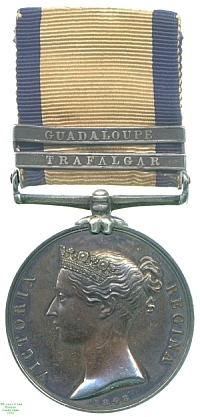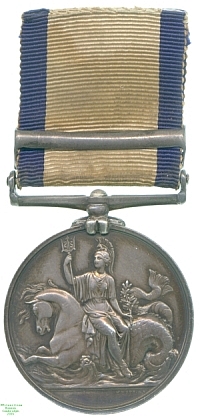
Obverse, a bust of Queen Victoria

Reverse, Britannia with a trident seated sideways on a seahorse

Obverse, a bust of Queen Victoria |

Reverse, Britannia with a trident seated sideways on a seahorse |
Just as in 1848 the extensive land campaigns of the Napoleonic Wars and the other conflicts of the pre-Victorian era were recognised by the issue of the Military General Service Medal, those serving in the Navy at the time were recognised with the Naval General Service Medal. As with the Army equivalent and the East India Company's related award, many of the battles for which the medal was awarded had been fought so long ago that few if any claimants survived.
In addition, bars were awarded for many actions whose significance and size were, despite the heroism displayed by those involved, relatively minor. The result was that many of the bars were issued in tiny numbers, with some combinations all but unique, and the medals command a very high price among collectors because of this rarity and individuality. This in turn, along with the manufacture in most cases of more bars than were eventually issued, has led to the `improvement' of many common awards where recipients' names are shared with those present at `rarer' battles. The medal also shares with the Military General Service and Army of India Medals the oddity that Queen Victoria, whose portrait they bear, was not the ruler under whom the battles for which it was awarded were fought.
The Battle of Trafalgar is so famous as almost to need no description. By 1805 Napoleon had determined to defeat, once and for all, the British blockade that prevented the formidable fleets of France and Spain from joining their forces on the high seas, and a successful combination of the French Mediterranean Fleet and Spanish fleet in that year might have heralded the invasion of Britain but for several skirmishes preventing the allied ships meeting the French invasion fleet at Brest. Instead, the combined fleet took refuge in Cadiz and here Admiral Horatio Nelson gathered an increasing, if rather disparate, force of ships to try to engage the enemy.
Nelson's plan involved an attack in two formations to fall upon the French rearguard and cutting off these ships before starting a melée in which superior British gunnery and training (largely due to the years of blockade enforced upon the enemy) would ineluctably tell. Once out of Cadiz, the French Admiral Pierre Villeneuve changed his formation to meet the oncoming British several times and was obeyed only slowly, resulting in disorganisation, but the Franco-Spanish fleet still outnumbered Nelson's considerably. Although the first British ships to come within range of the enemy were heavily damaged in the approach that Nelson's plan required, the concentration that it brought on the Franco-Spanish centre meant that these vessels were heavily attacked before their fellows could come to their aid, and the eventual inevitable progress of the battle led to 22 French and Spanish vessels being taken by the British, and only 11 returning to Cadiz; 4 more that escaped were taken at the Battle of Cape Ortegal. Although numerous British ships were heavily damaged, none were lost; the most significant damage to the British fleet was of course the death of Nelson, shot by a sniper from the French Redoutable, shortly afterwards prevented from boarding Nelson's flagship HMS Victory by an attack from HMS Temeraire and finally taken. Nelson's death was mourned on a wide scale in Britain, and Napoleon had already abandoned his invasion plans in favour of Italian campaigns, but Nelson's victory prevented the Franco-Spanish fleets making any serious contribution to their war effort for the rest of the Napoleonic Wars. His flagship Victory is preserved at Portsmouth and is still in official commission in the Navy. Villeneuve, captured by the British, was found stabbed in his cabin having apparently committed suicide.
The second bar on this medal relates to the capture in 1810 of the island of Guadaloupe, discovered by Columbus in 1493, taken over by the French in 1635, captured by Britain in 1759, and then back to France 1763, being held briefly by Britain in 1794. A substantial British fleet took possession of the island in 1810, and the island was then given to Sweden to induce that state to join the alliance against France. Guadaloupe would be returned to France again in 1814, taken back in 1815 and returned again finally later that year.
This medal is inscribed to one George Ryder, but no man of this name is recorded in the Medal Roll as having received these bars. One such man did however receive the much commoner bar for Syria, and it is likely that this is in fact the Syria recipient's medal with spare bars for the rarer and more prestigious awards tooled on to increase the piece's value. Despite this Lester Watson acquired the medal at some point before 1928.